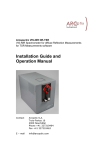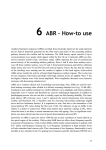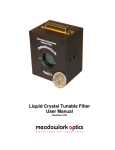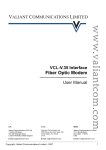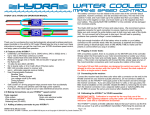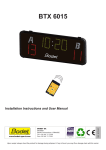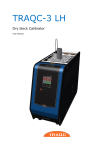Download USER MANUAL
Transcript
ARCoptix Radial Polarization Converter With LC Driver USER MANUAL Arcoptix S.A Ch. Trois-portes 18 2000 Neuchâtel Switzerland Mail: [email protected] Tel: ++41 32 731 04 66 User Manual polarization converter ARCoptix Switzerland – www.arcoptix.com Principle of the radial polarization converter The most important element is the radial polarization converter described in Stalder et.al. Opt. Lett. 21 (1996) 1948. The entrance and the exit plates of the cell are linearly and circularly rubbed, respectively. The direction of the linear rubbing on the entrance plate determines the cell axis. Each LC molecule chain is characterized by a twist angle (i.e. the angle between the orientation of the molecules at the entrance and at the exit plates) that is a function of the angular position with respect to the cell axis. When the polarization-guiding conditions are met, a linearly polarized beam incident on the entrance plate, propagating parallel to the polarization converter normal and with electric field vector parallel or perpendicular to the cell axis experiences a rotation of its polarization direction by the twist angle. This phenomenon occurs for a broad range of wavelengths (twisted nematic cell optics in the waveguide limit). Having a closer look to the cell texture in their stable configuration, as drawn in Fig.1, one realizes that there are two parts with different sense of rotation. Figure 1. Liquid crystal alignment in the polarization converter for a stable configuration. The line in the center represents a defect line present because of different twist sense of the upper and lower part. The arrow represents the entrance polarization. While on the top half the rotation is clockwise, the lower part is characterized by counterclockwise rotation. In this case, a defect line running along the diameter parallel to the cell axis arises. A thin defect line is caused by different rotation sense in the two parts of the cell and is for a non-chiral liquid crystal mixture along the rubbing direction (cell axis). The defect line is drawn as black horizontal line in the Fig. 1. -1- User Manual polarization converter ARCoptix Switzerland – www.arcoptix.com Next the polarization rotation properties are discussed. Linear polarized light is entered from the side with linear rubbing. Two different polarization states are created when linear polarized light enters parallel or perpendicular to the cell axis. Figure 2 visualizes the polarization states. The small arrows are used to indicate the polarization state of light. A B Figure 2. Azimuthally and radially polarizations. The double arrows indicate the phase of the beams that has a mismatch at the disclination line. The big arrow represents the entrance polarization. Azimuthally polarized light is achieved for light incident parallel to the cell axis (rubbing direction). Radially polarized light is achieved for light incident perpendicular to the cell axis. In the following, the definitions of azimuthally and radially polarized beams will be used to indicate the two configurations displayed in Fig. 2 (A) and (B), respectively. General description of the system: The complete system (if ordered with all the options) is shown in figure 3. It consist of the polarization converter (theta-cell) itself, a phase compensator that permits to compensate the O/2 phase step between the upper and the lower half of the theta cell and a twisted nematic cell capable to rotate the entrance polarization by 90° and permits to switch between the azimuthal and radial polarization distribution. One half of the phase compensator (delimited by the black line in figure 3) is provided with an electrode that permits to change the inclination angle of the LC molecules, which changes its extraordinary refraction index. By applying a bias on between the electrodes the retardance is reduced compared to the second half where the retardance stays constant at 1260nm. -2- User Manual polarization converter ARCoptix Switzerland – www.arcoptix.com incident linear polarization retarder cell converted polarization polarization rotator T-cell Figure 3. Liquid crystal cell configuration in the converter element. Linear polarized light enters from the left first the phase compensator (retarder) cell, might be rotated by the polarization rotator and exits either radially or azimuthally polarized from the polarization converter. The complete system (polarization converter + TN cell+ variable phase Compensator (retarder or shifter) is integrated into an aluminum housing as shown in figure 4. The polarization converter can be rotated and translated with respect to the TN cell and the phase compensator with the rotation lever and the x-y adjustment screws. Two wires must be connected to a conventional labor AC power supply for stetting the adequate phase retardation depending of the used wavelength and to the two other wires must be connected to a second power supply capable to switch between 0 and (at least) 5V (see electrical connection section). The side with the small aperture is the entrance of the device and side with the large aperture is the output of the device -3- User Manual polarization converter ARCoptix Switzerland – www.arcoptix.com Rotation adjustment lever of the theta cell Adjustment screw of the theta cell Input Polarization direction Exit Aperture Electrical control wires of the phase Compensator and the TN cell Figure 4: The liquid crystal polarization converter in its final housing. The clear aperture is 10 mm. Notice that in figure 4 the polarization converter (between polarizers) is illuminated with white diffuse light. If the system is illuminated with a collimated coherent laser beam the defect line (pi phase step) of the theta cell produces a diffraction pattern (low intensity line in the center) that disturb the intensity profile at the output of the system (see figures in the alignment section). This line disappears when an additional phase compensator is inserted in the system to compensate the pi phase shift of the theta cell. A further spatial filter after the polarization converter may be used to clean up some residual inhomogenities in the intensity profile. -4- User Manual polarization converter ARCoptix Switzerland – www.arcoptix.com Electrical connections: If included in your system (depending of the options) the twisted nematic cell (responsible to rotate the entrance polarization by 0° or 90°) and the phase Compensator (responsible to correct the phase step between both sides of the radial polarization converter) needs to be connected to an alternative (AC) power supply. If you are using the ARCoptix LC driver, connect simply the two cables marked “RAD/AZIMU.” And “PHASE COMP.” of the polarization converter on the two outputs of the LC DRIVER (order does not matter). Notice if your are NOT using the LC Driver you need a stable AC Power supply (or function generator) producing ideally a square wave signal (but sinusoidal is also possible) with change of polarity (oscillating between positive and negative bias). The frequency of the applied bias is not crucial, ideally it should be somewhere around 1 kHz. The amplitude should be as stable as possible. A standard laboratory function generator may be perfectly adapted as power supply. - Supplying the TN cell: The TN cell is supplied with the wire marked “RAD./AZIMU.” When a bias of (at least) 5 V rms (the best is to set to the maximum 8.8 V) is applied the cell is switched ON and the entrance polarization is not rotated. In this case at the output of the system presents a radial polarization distribution. When the TN cell is switched OFF (0V), one obtains an azimuthal distribution. - Supplying the phase shifter: The phase Compensator (or retarder) is supplied with the wire marked “PHASE COMP.” (such as phase step compensation). When a bias is applied a phase shift between the upper and lower part is produced. The dependency of the phase shift versus the bias (rms) is given in the graphic in the annex. Connection noted TN cell Bias (rms) 0V OFF “Rad./Azim.” ~8V ON Phase “phase 0-8V Compensator Comp.” Table 1: summary of the electrical polarization converter system Frequency Function ~ 1.6kHz Switch between radial and azimuthal polarization ~ 1.6kHz connections Homogenise the phase of the radial -5- User Manual polarization converter ARCoptix Switzerland – www.arcoptix.com Operation of the LC Driver (see also lc driver manual) Before using the LC driver, make sure that the program and drivers are correctly installed on you computer. Notice that for the moment not possible to drive two different drivers from the same computer. When starting the program you get the following window (non triggered version): The output controls (output 1 and output 2) correspond to the two outputs on the LC Driver. One can control output via - The rotation button (rough control) - The edit window just below the rotation button. - With up and down arrows of the keyboard - With the scroll wheel of the mouse (if any present) For precise scanning of the voltage (if adjusting the phase of the variable phase retarder or phase compensator for example) with the up and down arrows or the mouse scroll wheel, one can set the precision of a single step with the voltage resolution selection. To select the output controlled by the arrows or the scroll wheel of the mouse: click on the corresponding rotation button. The maximum precision of the LC Driver is 1mV. And the maximum amplitude of the square signal is about ±8.8V. The constant frequency of the output voltage is 1.6 KHz If the check box “same as Output 1 is checked then both outputs are identical and are both controlled by output 1. Terminate the program by simply pressing the red cross button in the upper right corner (as usual for windows programs). -6- User Manual polarization converter ARCoptix Switzerland – www.arcoptix.com Alignment of the system This section is only of interest if the option including the phase compensator has been purchased. If the theta-cell is used in combination with a phase compensator (for phase compensation), both elements have to be accurately aligned for optimal performances of the system. The TN cell (if this option is integrated in the system) is glued to the phase compensator and has already been permanently aligned during the assembly of the system. The transparent ITO electrode of the phase compensator has to cover one half of the theta-cell in order to be able to compensate the O/2 phase step between the upper and the lower part of the system. This means that the defect line of the theta-cell and the edge of the electrode of the phase compensator has to superpose as shown in figure 5. In order to avoid any inhomogeneous intensity distribution at the output (in particular for the short wavelengths where the absorption of the ITO becomes important), the phase compensator has been completely covered with the ITO electrodes but only one half (which is isolated from the other half) is electrically connected. Figure 5: The edge of the electrode (green area) is superposed to the defect line (red) of the theta cell. However the edge of the transparent electrode and the defect line can hardly be distinguished by bear eye. It is suggested to use the setup described in figure 6 for the alignment of the system and for the adjustment of the bias of the phase compensator. The setup of figure 6 consists of a homogenous collimated laser beam with a diameter of 1 cm that is polarized by a first polarizer at 0°, -7- User Manual polarization converter ARCoptix Switzerland – www.arcoptix.com passes through the phase compensator and the theta-cell. Finally the beam passes through a second polarizer also oriented at 0° or 90° and the beam is observed with an ordinary CCD camera or by eye. Polarization converter CCD LASER LASER Transparent electrode Defect line TN cell Figure 6: setup for alignment of the theta cell with respect to the phase compensator and for adjustment of the bias on the phase compensator to obtain a O/2 phase shift. 1) Alignment of the theta cell with the phase compensator: In the first step, for the alignment of the system, it is more comfortable to remove the second polarizer. On the CCD camera (or simply projection on the wall) you will typically observe, as shown in figure 7a, two close black lines that may be rotated and translated to each other. These black lines are diffraction patterns created by the defect line (phase step) and the phase step at the edge of the electrode of the phase compensator. Notice that you will only see this diffraction pattern when using coherent light. The phase step does not produce any pattern in the far field when using incoherent light. Notice however that a dark spot will remain in the center. This due to the phase-polarization singularity in the center of the theta cell. Alignment procedure (only possible when using coherent light): 1) Build the setup of figure 6. 2) Make sure that the polarization converter is oriented correctly: large aperture is the output and small aperture is the entrance of the device 3) Make sure that the incoming light is linearly polarized and correctly oriented with respect to the device (see figure 4) -8- User Manual polarization converter ARCoptix Switzerland – www.arcoptix.com 4) You may remove here the second polarizer but it is not absolutely necessary. Notice that the images of figure 7 were made with an output polarizer. 5) Connect the cable of the Polarization converter noted “phase comp.” to your power supply (out1 or out2 of the LC Driver). 6) Vary the bias between 0 and 3V until the second black line due to the phase compensator (phase retarder) clearly appears (minimum of intensity) at the output of the theta cell (figure 7A and 7B). Notice that for wavelength below 800nm two (or three) different biases are possible. Notice that the two lines may by chance already superpose due to factory pre-alignement, move x-y screws and change bias to check this. 7) Rotate and translate the theta-cell with the rotation lever (should be very close to the vertical position) and the x-y translation screws (see figure 4) until the two lines are perfectly superposed and with the CCD camera you observe only one line as shown in figure 7C. Notice that it is possible that the two lines already superpose, move x-y to check this. Notice that if using incoherent light (or weakly coherent) the alignment is not possible this way. We suggest you first align the system with a laser and then change your light source. 2) Adjustment of the bias of the phase Compensator: The variable phase Compensator (or retarder or shifter) is a transparent cell providing a tunable phase delay between the two halves of the beam passing through it. It is integrated in the housing in the front of the polarization rotator cell. The active area covers half the useful aperture as illustrated in Fig 5. With a thickness of 9Pm and filled with the liquid crystal with a birefringence of 'n=0.14 the cell gives a maximum retardation of 1260 nm at room temperature. If voltage is applied, the retardation can be reduced continuously. (see Annex) To compensate the O/2 phase step produced by the theta-cell between the upper and lower half (or left and right depending how inserted the theta cell in your setup) the bias applied on the phase compensator must be adapted according to the used wavelength. When the bias is correctly adjusted to obtain a O/2 phase shift and the defect line of the theta cell is perfectly aligned with edge of the phase compensator electrode, the black diffraction line should significantly be reduced to finally obtain the intensity distribution of figure 7D. Notice however that a dark spot will remain in the center. -9- User Manual polarization converter ARCoptix Switzerland – www.arcoptix.com Bias adjustment procedure: 1) Rotate the second polarizer in such way (0° or 90°) that the black cross is perpendicular to the diffraction line (make the diffraction line well visible) 2) Adjust the bias (around 1 to 3V depending of the wavelength) until the black diffraction line disappears. For a wavelength of 633nm this would correspond to a theoretical phase retardance of 633/2=316 nm which is obtained with a bias of about 1.5 V a second possibility would be 316+633=949 nm which is obtained with a bias around 2.9 V (see annex). 3) In principle further adjustment of the x-y screws and the rotation lever are necessary to make the black diffraction line almost disappear. 4) The TN cell can be checked by applying a bias of about 5V. The black cross should rotate by 90° and if the system is correctly aligned the black diffraction line should not appear again. This due to the phase-polarization singularity in the center of the theta cell. A B C D Figure 7: Intensity distribution at the output of the polarization converter system when placed between two polarizers oriented at 0°90°. A: the phase compensator and the theta cell are rotated with respect to the theta cell. Misalignment -> use the rotation lever to parallelize the two lines, the lever should oriented vertically. B: the phase compensator is translated with respect to the theta cell -> use the x-y screws to superpose the two lines. C: the two diffraction lines are superposed -> adjust the bias of the phase compensator until the lines disappears. D: The system is properly aligned and ready to be used. Other use recommendations: The polarization converter may show some small beam deviation (<5 Arc Sec.). This can be compensated by slightly tilting the entrance beam. Also non-linear (mostly spherical) aberrations can eventually compensated with a defocus of the entrance beam. Another optimization such as the adjustment of bias applied on the TN cell may enhance the quality of the output mode (especially when you -10- User Manual polarization converter ARCoptix Switzerland – www.arcoptix.com try to make donut focus points). This adjustment could permit the TN cell to function in a minimum of the “Gooch-Tarry curve”. Also for some applications (where the beam is injected in another optical component) it is important that the center of the radial distribution coincides perfectly with the center of the laser (and the aperture of the microscope objective). It may be that the edge of the phase compensator is slightly off the centre (up to 0.5 mm) with respect to the center of the aperture. It is recommended to fix the housing on a x-y stage for adjustment. For diffraction limited application where a very good beam quality in amplitude and phase is necessary (for example reduced focus point with high NA microscope objectives), it is recommended (when enough intensity is at your disposal) to clean up the beam after the polarization converter with a pinhole (spatial filter) setup. Annex: The Retardation (d(ne(V)-ne)) between the two halves of the retarder cell measured as a function of Vamplitude (1 kHz square wave) and for a wavelength of 633nm (retardation may have a slight wavelength dependency). Troubleshooting: The following question may help to solve eventual functioning problems of the polarization converter: 1) Is the input light polarized and the polarization along the housing as indicated in the manual? 2) Did you correctly orient the pol. converter (big aperture is the output)? 3) Do you see the two diffraction lines in the far field when illuminating with a collimated laser light? 4) Do you see an intensity variation (if you put a polarizer at the output) of one of the diffraction lines if you change the bias of the phase compensator? 5) Can you align the two diffraction lines with the help of the x-y screws and the rotation adjustment lever? 6) Do see almost disappear the diffraction line (if the two lines are correctly superposed) by adjusting the bias of the phase compensator (somewhere between 1 and 3V amplitude depending of the wavelength)? 7) Does the polarization distribution switches from azimuthal to radial if you switch on the TN cell (control the orientation of “the black cross” is the far field with respect to the output polarizer orientation). -11- User Manual polarization converter ARCoptix Switzerland – www.arcoptix.com -12-













